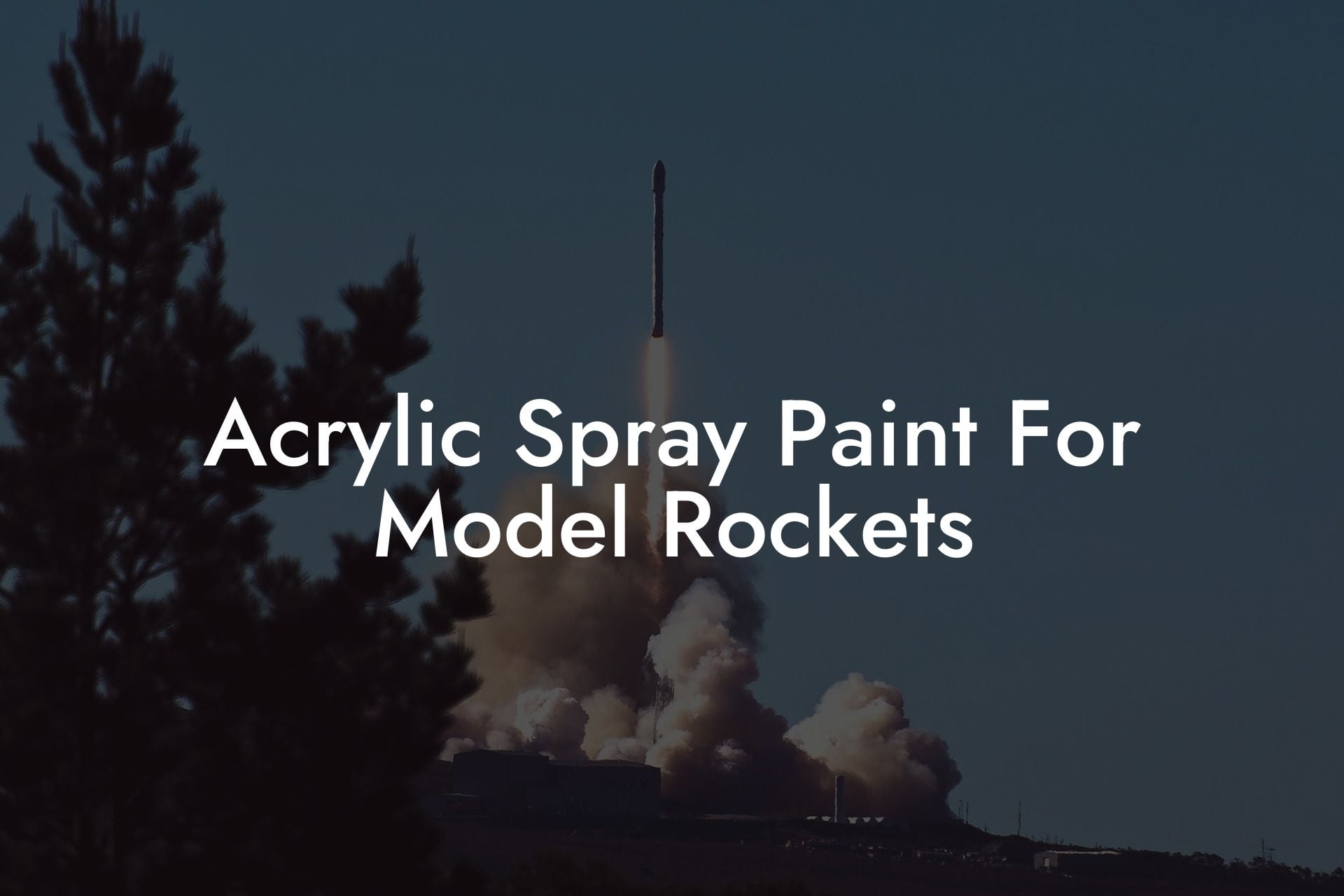Imagine blasting off into the world of model rocketry, where vibrant colors and sleek designs take your creations to new heights. Welcome to the realm of acrylic spray paint for model rockets, where art meets technology and precision meets passion. Whether you're a seasoned rocketeer or just starting out, this comprehensive guide will propel you into the stratosphere of model rocket customization.
Quick Links to Useful Sections
- Why Acrylic Spray Paint for Model Rockets?
- Choosing the Right Acrylic Spray Paint for Your Model Rocket
- Tips and Tricks for Painting Your Model Rocket with Acrylic Spray Paint
- Common Mistakes to Avoid When Painting Your Model Rocket with Acrylic Spray Paint
- Resources and community Support: Your Next Steps
- Frequently Asked Questions: Acrylic Spray Paint for Model Rockets
Why Acrylic Spray Paint for Model Rockets?
Acrylic spray paint is the go-to choice for model rocket enthusiasts due to its unique blend of durability, versatility, and ease of use. Unlike traditional brush-on paints, acrylic spray paint provides a smooth, even finish that resists chipping and fading, ensuring your model rockets look stunning even after multiple launches.
With a vast array of colors and finishes available, acrylic spray paint unlocks endless possibilities for customization. From realistic military camouflage to bold, neon hues, the right paint job can elevate your model rocket from mere hobby to breathtaking work of art.
Choosing the Right Acrylic Spray Paint for Your Model Rocket
With so many options available, selecting the perfect acrylic spray paint for your model rocket can seem daunting. Here are some key factors to consider:
- Color and Finish: From matte to glossy, metallic to neon, choose a paint that matches your desired aesthetic.
- Brand and Quality: Look for reputable brands that specialize in model rocket paint, ensuring a high-quality finish and durability.
- Surface Preparation: Make sure the paint is compatible with your model rocket's surface material, whether it's plastic, wood, or another material.
By considering these factors, you'll be well on your way to selecting the ideal acrylic spray paint for your model rocket masterpiece.
Looking For The Best Model Rocket Kits? You'll Love These:
Tips and Tricks for Painting Your Model Rocket with Acrylic Spray Paint
To achieve a professional-looking finish, follow these expert tips and tricks:
- Prepare Your Surface: Clean and sand your model rocket's surface to ensure a smooth, even application.
- Use a Primer: Apply a primer specifically designed for model rockets to ensure optimal paint adhesion and durability.
- Thin Coats: Apply multiple thin coats of paint, allowing each coat to dry before applying the next, to prevent drips and unevenness.
- Masking and Stencils: Use masking tape and stencils to create crisp, sharp lines and intricate designs.
By following these guidelines, you'll be able to achieve a stunning, high-quality finish that showcases your model rocket's unique personality.
Common Mistakes to Avoid When Painting Your Model Rocket with Acrylic Spray Paint
Even the most seasoned model rocket enthusiasts can make mistakes. Here are some common pitfalls to avoid:
- Insufficient Surface Preparation: Failing to properly clean and sand your model rocket's surface can lead to a poor paint job.
- Inconsistent Coat Thickness: Applying coats that are too thick or too thin can result in an uneven finish.
- Not Allowing Proper Drying Time: Rushing the painting process can cause the paint to dry too quickly, leading to unevenness and imperfections.
By being aware of these common mistakes, you can take steps to avoid them and ensure a flawless, show-stopping finish.
Resources and community Support: Your Next Steps
Join the vibrant community of model rocket enthusiasts and take your skills to the next level:
- Online Forums and Groups: Connect with fellow model rocket enthusiasts, share tips, and learn from others in online forums and groups dedicated to model rocketry.
- Tutorials and YouTube Channels: Follow expert model rocket builders and painters on YouTube and other platforms for step-by-step guides and inspiration.
- Local Model Rocket Clubs: Join a local model rocket club or attend events to network with other enthusiasts, learn new techniques, and showcase your creations.
By tapping into these resources, you'll be able to stay up-to-date on the latest techniques, learn from others, and share your own experiences with the model rocket community.
Frequently Asked Questions: Acrylic Spray Paint for Model Rockets
Get answers to your most pressing questions about using acrylic spray paint for model rockets:
1. What is the best brand of acrylic spray paint for model rockets?
Look for reputable brands that specialize in model rocket paint, such as Tamiya, Testors, or Vallejo.
2. How long does it take for acrylic spray paint to dry on a model rocket?
Drying time varies depending on the brand and environmental conditions, but typically ranges from 15 minutes to several hours.
3. Can I use acrylic spray paint on plastic model rockets?
Yes, acrylic spray paint is suitable for plastic model rockets, but make sure to choose a paint specifically designed for plastic surfaces.
4. How do I achieve a smooth, even finish with acrylic spray paint?
Apply multiple thin coats, allowing each coat to dry before applying the next, and use a primer to ensure optimal paint adhesion.
5. Can I mix acrylic spray paint with other materials to create custom colors?
Yes, you can mix acrylic spray paint with other materials, such as lacquer thinner or custom pigments, to create unique colors and effects.
Looking For The Best Model Rocket Kits? You'll Love These:
Useful Interruption: Dive deeper into the world of Model Rockets with our most popular sections. If there is anything you think is missing or anything you would love for us to write about, just give us a shout.
- Getting Started & Basics With Model Rockets
- Model Rocket Design, Build & Customization
- Model Rocket Propulsion & Engine Technology
- Model Rocket Launch Techniques & Recovery
- Model Rocket Advanced Rocketry & Innovations
- Model Rocket DIY and Customization
- Model Rocket Equipment Reviews & Digital Tools
- Community, Competitions & Education
- Model Rocket Troubleshooting & FAQs
- Model Rocket Bonus/Seasonal & Niche Topics
A group of model rocket enthusiasts gathered at a field for their weekly launch event. Among them was Dave, a seasoned builder known for pushing the limits of hobby rocketry. This time, he had outdone himself.
“Ladies and gentlemen,” Dave announced, dramatically pulling a cloth off his latest creation, “I present to you: The Kraken!”
The crowd gasped. This wasn’t just a model rocket, it was a monster. The thing stood 8 feet tall, had six clustered engines, and was covered in enough duct tape to qualify as a classified aerospace project.
“Dave,” muttered Steve, the cautious safety officer, “Have you, uh… done the math on this?”
“Math?” Dave scoffed. “I built it in my garage at 3 a.m. with parts from eBay. This is an art piece, Steve.”
The countdown began.
5…
4…
3…
2…
1…
The engines ignited with a BOOM, and The Kraken shot up… kind of. It immediately did a violent barrel roll, narrowly missing the spectators before skyrocketing at an angle that could only be described as “legally questionable.”
The crowd collectively ducked as The Kraken flew straight over the adjacent cornfield, where Old Man Jenkins, the grumpiest farmer in town, was minding his business.
KABOOM!
The rocket disappeared behind the barn. A moment later, a flaming piece of Estes igniter wire landed at Steve’s feet. The silence was deafening.
And then, an unmistakable sound echoed across the field.
Jenkins’ shotgun being cocked.
“DAVE!!!” Steve shouted. “RUN.”
And that was the day Dave invented the first-ever biologically powered rocket booster: pure adrenaline.
To this day, nobody knows where The Kraken landed, but legend has it, it still haunts the skies, terrifying unsuspecting drones and low-flying birds.















